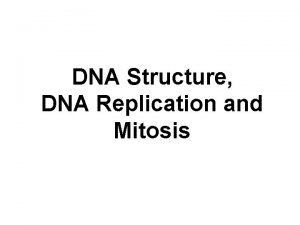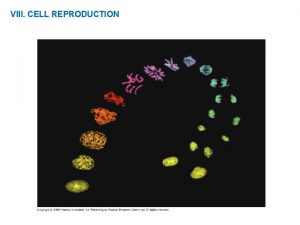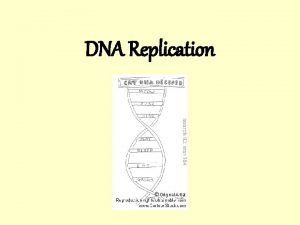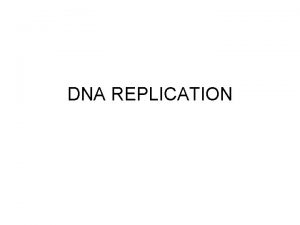DNA Replication Replication and cell division All DNA











- Slides: 11

DNA Replication

Replication and cell division • All DNA must be copied before cell division (mitosis) so each daughter cell can receive a complete set. • DNA replication occurs during the S phase of the cell cycle, before chromatin condenses into chromosomes. http: //ghr. nlm. nih. gov/handbook/illustrations/chro mosomestructure. jpg


3 main steps to replication • Step 1 – Helicase unzips the DNA strand by breaking the hydrogen bonds between base pairs; creates two new “template” strands • Step 2 – DNA polymerase inserts new complementary bases (and builds P/S backbone) • Step 3 –DNA polymerase proofreads the sequence; fixes errors

Antiparallel strands of DNA • Notice that one strand is always upside-down relative to the other strand? • The two strands are antiparallel to each other

Direction of replication • One DNA strand forms in the same direction that helicase unzips it • The other one must go the other way (because DNA is antiparallel) • This causes fragments of DNA to form, which are then later sealed by another enzyme You. Tube: DNA Replication Process You. Tube: DNA Replication

The result of replication is… …two new strands of DNA that are exactly the same as the original strand

Why is DNA called semiconservative? • DNA replication is called semi -conservative because each strand has an old part and a new part • Semi = half or part; conservative = preserving the old ways

DNA replication is very accurate • DNA polymerase laying down new nucleotides makes 1 error per 1, 000 nucleotides • Sounds good? • 3, 000, 000 base pairs in the each human cell… 3, 000 possible errors each time our cells replicate • BUT…after DNA Polymerase is done, other enzymes “proofread” and correct the new strand • Afterward, the error rate is about 1 error per 10, 000, 000 or 1 error every 3 cell divisions.

Base pairing practice For each example below, give the correct complementary strand of DNA. – TTGCTAG – AACGATC – TAGCGCT – ATCGCGA – ACCGTCA – TGGCAGT – GCTATGT – CGATACA

Replication practice TGC AG TGCAGAT AT DNA polymeras epolymerase helicase ACG T C ACGT CT T new strands old strands
 Bioflix activity dna replication nucleotide pairing
Bioflix activity dna replication nucleotide pairing Replication fork
Replication fork Dna rna protein synthesis homework #2 dna replication
Dna rna protein synthesis homework #2 dna replication Events of the cell cycle
Events of the cell cycle Cell cycle and cell division
Cell cycle and cell division Cell cycle mitosis
Cell cycle mitosis Haploid vs diploid
Haploid vs diploid Multiple choice questions on dna structure and replication
Multiple choice questions on dna structure and replication Dna replication transcription and translation
Dna replication transcription and translation Dna replication
Dna replication Cell of reproduction
Cell of reproduction Name all the lines name all the segments name all the rays
Name all the lines name all the segments name all the rays





















